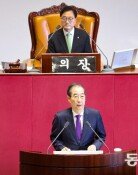Uijeongbu site needs informative restoration
Uijeongbu site needs informative restoration
Posted July. 20, 2024 08:04,
Updated July. 20, 2024 08:04
“It’s so desolate that there are only ‘stones’ here and there, and I don’t even know what they mean,” said Ms. Lee (48), whom I met at the ‘Uijeongbu historic site’ in front of Gwanghwamun in Seoul on Thursday. “I came here after visiting Gyeongbokgung Palace with my children on summer vacation, but it was below my expectations. Foreign tourists around the place were also busy glancing at the English signboard and ‘stones’ before moving on to Gyeongbokgung Palace across the street.
The ‘stones’ they saw were reproductions of cornerstones that showed the location of the Uijeongbu, the highest administrative body of the Joseon Dynasty. The actual foundation stones from the Joseon Dynasty are buried under the covered grass. The city of Seoul unveiled the historic site square last month after completing excavation and maintenance at the Uijeongbu site for about eight years, revealing a unique piece of history that was previously hidden.
However, in the 11,300㎡ square, there is only a reproduction of the cornerstones, a restroom, and a few benches. The signboard at the entrance only records the historical origins of Uijeongbu, and you cannot find a single line of the story of major figures such as Jeong Do-jeon or Hwang Hui, who dedicated their lives here. Unless you are well versed in ancient architecture or Joseon's history, it is not easy to appreciate the historical significance just by looking at the stones.
During the Joseon Dynasty, Uijeongbu was not a simple state institution. It had the status of the highest administrative institution, to the extent that it was placed in the first place east of the main gate (Gwanghwamun) of Gyeongbokgung Palace, the main palace of the Joseon Dynasty. Above all, Uijeongbu condenses the vision and governing philosophy of Jeong Do-jeon, the reformer who designed Joseon. He writes in ‘Joseon Gyeonggukjeon (Administrative Code of the Joseon Dynasty),’ “A king can be foolish or wise, strong or weak, so he is not consistent. Therefore, the prime minister must complement the king’s shortcomings and leverage his strengths to guide him on the right path.” Even though it is a dynasty, his revolutionary ideas that the country should be run by a system, not by one person, are evident. The Joseon he envisioned was a country in which the king was prevented from trying to attend to every little detail of national affairs, and the prime ministers took the lead in actual governance. It is the product of a deliberate effort to provide comfort to the people through the stable administration of state affairs.
Accordingly, a structure was established in which the six ministries, corresponding to each administrative department, reported to or received instructions from the king through Uijeongbu, which was composed of three high-ranking officials. If there was a problem with the king's order, Uijeongbu actively checked the king's authority by objecting before it was passed down to the ministries. This is why King Taejong and King Sejo, who came to power through a coup, implemented the king's direct six ministries administration system (in which the king directly gave instructions or received reports from the six ministries) and neutralized Uijeongbu. This historical tradition is at the root of the argument that the recently overly concentrated power of the President's Office should be removed and the policy leadership of ministries should be restored.
In order to properly convey the various historical meanings of Uijeongbu to citizens, a few cornerstones are not enough. Some in the cultural heritage community advise that, as an alternative, storytelling that tells the stories of Uijeongbu and the figures who made significant contributions through performances, concerts, and debates is needed. These proposed enhancements have the potential to transform Uijeongbu into a vibrant cultural hub that celebrates its rich history. Another way is to establish a policy debate center to capitalize on the significance of Uijeongbu, which led national affairs through collective intelligence. To help visitors understand, it is also conceivable to restore part of the building or to build an exhibition hall on the outskirts of the ruins, such as the Hwangnyongsa Temple Site in Gyeongju.






